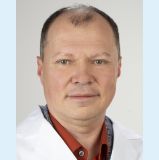
University Clinic of Dentistry
Position: Associate Professor
ORCID: 0000-0002-0485-2142
T +43 1 40070 2620
oleh.andrukhov@meduniwien.ac.at
Keywords
Immunomodulation; Inflammation; Mesenchymal Stromal Cells; Periodontal Diseases; Periodontal Ligament; Stem Cell Research
Research group(s)
- Competence Center for Periodontal Research
Head: Oleh Andrukhov
Members:
Research interests
My main research focus is investigation of cellular and molecular mechanism involved in homeostasis of periodontal tissue in health and disease: regulation of inflammatory response in periodontitis; host interaction with bacteria and bacterial biofilms, dental stem cells and their role in tissue regeneration and immunomodulation; effect of titanium surface roughness on micron- and nanoscale on the cell response and osseointegration.
Techniques, methods & infrastructure
The following techniques and approaches are routinely used in our lab:
- Isolation and in vitro cell culture of different human primary cells (e.g. monocytes, T-cells, neutrophils, dental stromal cells).
- 3D cell culture in hydrogels.
- Various co-culture models with and without cell-to-cell contact.
- A broad spectrum of biochemical and cell biological, and imaging techniques, including qPCR, flow cytometry, western blot etc.
- Cell imaging, fluorescence microscopy.
- Application of tension and compression forces to cells in vitro.
- Rheometry.
Our research laboratory is equipped with all instruments required for experiments in cellular and molecular biology:
- Laminar air flows
- RT-PCR instrument
- Plate reader (absorbance, luminescence, fluorescence)
- Flow cytometer equipped with autosampler
- MACS separator
- Equipment for electrophoresis and western blot
- Thermocycler
- Flexcell tension and compression systems
- Fluorescent microscope
- Rheometer
Grants
- Vitamin D3 metabolism in dental MSCs (2024)
Source of Funding: FWF (Austrian Science Fund), Principal Investigator Projects
Principal Investigator - Immunomodulatory abilities of periodontal MSC subpopulations (2021)
Source of Funding: FWF (Austrian Science Fund), Principal Investigator Projects
Principal Investigator - Tannerella forsythia’s impact on commensal oral biofilm (2021)
Source of Funding: FWF (Austrian Science Fund), Principal Investigator Projects
Principal Investigator - Vitamin D and immunomodulation by mesenchymal stem cells (2016)
Source of Funding: FWF (Austrian Science Fund), Stand-Alone Projects
Principal Investigator
Selected publications
- Behm, C. et al. (2024) ‘Heterogeneity in Dental Tissue–Derived MSCs Revealed by Single-Cell RNA-seq’, Journal of Dental Research, 103(11), pp. 1141–1152. Available at: https://doi.org/10.1177/00220345241271997.
- Behm, C. et al. (2024) ‘Paracrine- and cell-contact-mediated immunomodulatory effects of human periodontal ligament-derived mesenchymal stromal cells on CD4+ T lymphocytes’, Stem Cell Research & Therapy, 15(1). Available at: https://doi.org/10.1186/s13287-024-03759-4.
- Andrukhov, O. et al. (2019) ‘Immunomodulatory properties of dental tissue-derived mesenchymal stem cells: Implication in disease and tissue regeneration’, World Journal of Stem Cells, 11(9), pp. 604–617. Available at: https://doi.org/10.4252/wjsc.v11.i9.604.
- Blufstein, A. et al. (2024) ‘Salivary microbiome and MRP‐8/14 levels in children with gingivitis, healthy children, and their mothers’, Journal of Periodontology, 95(11), pp. 1035–1047. Available at: https://doi.org/10.1002/jper.23-0632.
- Andrukhov, O. et al. (2020) ‘Effect of implant surface material and roughness to the susceptibility of primary gingival fibroblasts to inflammatory stimuli’, Dental Materials, 36(6), pp. e194–e205. Available at: https://doi.org/10.1016/j.dental.2020.04.003.